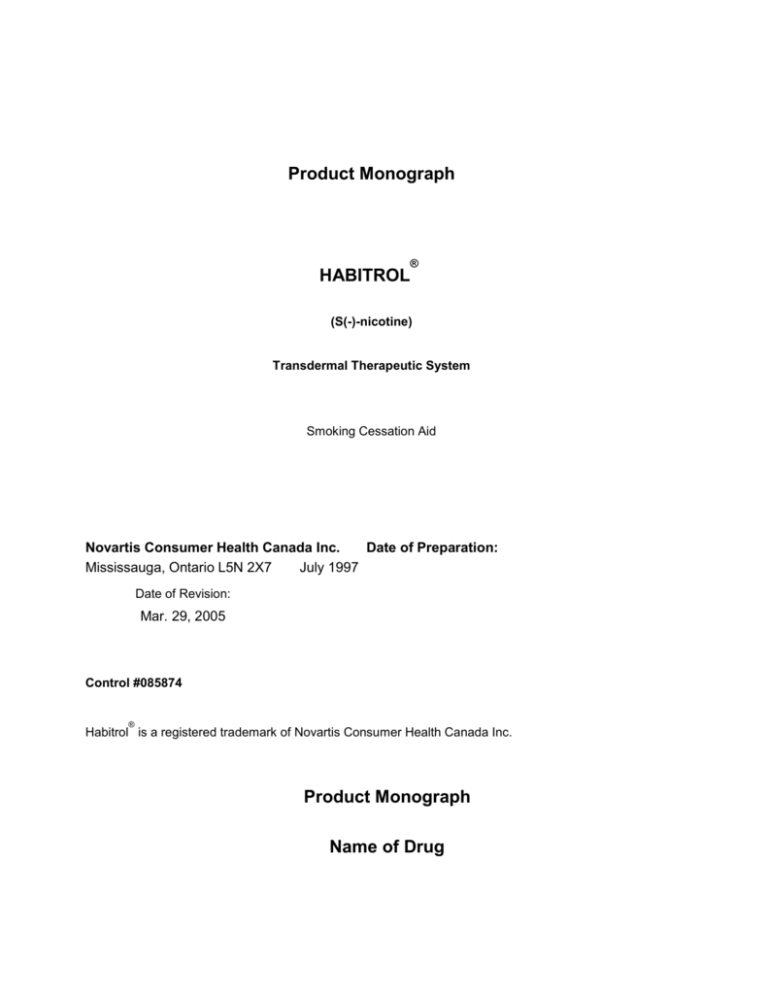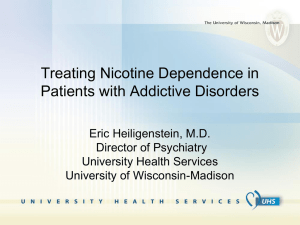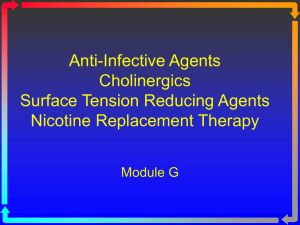Product Monograph
advertisement

Product Monograph ® HABITROL (S(-)-nicotine) Transdermal Therapeutic System Smoking Cessation Aid Novartis Consumer Health Canada Inc. Date of Preparation: Mississauga, Ontario L5N 2X7 July 1997 Date of Revision: Mar. 29, 2005 Control #085874 ® Habitrol is a registered trademark of Novartis Consumer Health Canada Inc. Product Monograph Name of Drug ® HABITROL (S(-)-nicotine) Transdermal Therapeutic System Therapeutic Classification Smoking cessation aid Actions and Clinical Pharmacology HABITROL (S(-)-nicotine) delivers S(-)-nicotine, the active component of tobacco smoke, transdermally into the systemic circulation, continuously over 24 hours. HABITROL releases S(-)-nicotine in controlled amounts at a rate sufficient to produce plasma nicotine concentrations comparable to trough levels observed in smokers before smoking a cigarette. Because of the low, continuous delivery of S(-)-nicotine through the skin, HABITROL does not produce the rapid increases in plasma nicotine concentrations that occur with cigarette smoking and which are primarily responsible for smoking's addictive effects. HABITROL has been shown to increase rates of cessation in smokers who are motivated to quit. Indications and Clinical Use HABITROL (S(-)-nicotine) is indicated as a temporary aid used to facilitate smoking cessation in smokers who strongly desire to give up their smoking habit. HABITROL is intended to be used as part of a smoking cessation strategy, and should, whenever possible, be combined with behavior modification therapy. Contraindications HABITROL (S(-)-nicotine) is contraindicated in: • non-smokers, occasional smokers, and children under 18 years of age (see Warnings), • known hypersensitivity of the skin, allergy to nicotine or HABITROL components, • generalized skin disorders, • recovery phase of acute myocardial infarction, unstable or worsening angina pectoris, severe cardiac arrhythmias, and recent cerebrovascular accident. Any form of nicotine administration is contraindicated in pregnant and breast-feeding women. Warnings In view of its pharmacological effects, HABITROL (S(-)-nicotine) should not be used in smokers with the following conditions unless there has been careful consideration of the risks and benefits of therapy: hypertension, stable angina pectoris, variant (Prinzmetal's) angina, cerebrovascular disease, occlusive peripheral arterial and vasospastic diseases, heart failure, hyperthyroidism, diabetes mellitus, renal and hepatic insufficiency, peptic ulcer. Use of HABITROL in these smokers should only be considered if tobacco withdrawal with psychological support alone has been unsuccessful. If these smokers continue to smoke while wearing HABITROL, excessive nicotine levels could be produced that can exacerbate pre-existing diseases and can cause serious adverse reactions (see Adverse Reactions). Adult smokers tolerate doses of nicotine that can be poisonous or fatal to children and pets. Both new and used HABITROL systems contain enough nicotine to cause serious harm if applied or ingested. Therefore it is important that smokers keep both new and used systems out of the reach of children and pets (see Information for the Consumer for the recommended disposal procedure). Treatment with HABITROL should be discontinued in cases of severe or persistent skin reactions. No experience is available on treatment with HABITROL in smokers under 18 years of age, and is limited in ages 65 years and above. Precautions Continued Smoking and Adverse Reactions: If the user continues to smoke while wearing HABITROL (S(-)-nicotine), adverse reactions consistent with excessive nicotine exposure, including cardiovascular effects, may be more frequent and more pronounced. Strenuous Exercise: Preliminary evidence suggests that wearing a nicotine transdermal patch during periods of strenuous exercise may lead to nicotine toxicity as a result of increased absorption of nicotine from the depot of nicotine in the skin under the patch, due to increase skin temperature and increased cutaneous vasodilation and perfusion from exercising. Three cases illustrating this phenomenon were described in Health Canada Adverse Reaction Newsletter, Volume 6, No. 1, Jan. 1996. Advice to remove the nicotine patch before engaging in strenuous exercise was recommended by: W. Dafoe and P. Huston, Current Trends In Cardiac Rehabilitation, Canadian Medical Association Journal, Feb 15, 1997; 156 (14): 527-532. Until definitive studies have been undertaken to clarify this hazard, it is advisable to remove the nicotine patch prior to engaging in strenuous activity. Effects on ability to drive or use machines: Nicotine acts as a central nervous stimulant agent. While no direct effect on reaction time is to be expected, the smoker should be cautioned that sleep disturbance, irritability and nervousness may occur during smoking cessation, and could affect performance. Drug Interactions: To date, no information is available on interactions between HABITROL and any other drugs. Experience with other forms of nicotine replacement therapy has shown that there are no pharmacodynamic or pharmacokinetic interactions of clinical relevance with various concomitant treatments. Tobacco withdrawal, with or without nicotine substitution, may alter the response to concomitant medication in ex-smokers. Through enzyme induction, smoking is thought to increase the metabolism - and thus lower the blood levels - of drugs such as antipyrine, caffeine, phenacetin, imipramine, lidocaine, pentazocine, warfarin, theophylline, oxazepam, lorazepam, desmethyldiazepam, and estrogens. Smoking cessation may result in increased blood levels of these drugs, therefore requiring appropriate adaptation of dose. Smoking reduces the analgesic efficacy of propoxyphene. Absorption of subcutaneous insulin may be increased upon cessation of smoking. Although the relevance to transdermal nicotine therapy is unknown, reported drug interactions with smoking which do not involve alteration of pharmacokinetics (e.g., enzyme induction) include: • increased cortisol concentrations. • increased circulating levels of catecholamines necessitating dose adjustments for adrenergic agonists (e.g., phenylephrine, isoproterenol), adrenergic a- and b- receptor antagonists, (e.g., prazosin and propranolol, respectively) and calcium channel blockers (e.g., nifedipine). • reduced diuretic response to furosemide, and reduced clinical efficacy of H 2- antagonists. Cessation of smoking may reverse these actions. Contact Sensitization to Nicotine: Contact sensitization to nicotine has been reported in transdermal nicotine users. Smokers developing this contact sensitization should be cautioned against using nicotine-containing products. Delayed type hypersensitivity reactions (e.g., generalized urticaria, edema) or severe allergic reactions could result. MRI Procedures: Habitrol patches should be removed prior to undergoing Magnetic Resonance Imaging (MRI) studies and/or MRI-guided procedures. Patches should be removed, regardless of the location of the patch, the anatomy being scanned, or the MRI device being used, in order to avoid the possibility of application site thermal burns, however infrequent or minor they may be. Adverse Events In principle, HABITROL (S(-)-nicotine) can cause adverse reactions similar to those associated with nicotine administered by smoking, or those that accompany tobacco withdrawal, especially in the GI and CNS systems. However, since the plasma S(-)-nicotine concentrations reached with HABITROL are substantially lower and fluctuate less than those produced by smoking, nicotine related adverse reactions occurring during treatment with HABITROL can be expected to be less marked. If the user continues to smoke while wearing HABITROL, adverse reactions consistent with excessive nicotine exposure may be more frequent and more pronounced. Severe and fatal adverse reactions have occurred in smokers that continued to smoke while using nicotine transdermal systems. Smokers are strongly advised to stop smoking during HABITROL therapy, especially high risk smokers, as described in Warnings. The most commonly reported adverse effect associated with HABITROL in clinical trials was skin reaction at the application site. This was responsible for about 6% of premature discontinuations and included symptoms such as erythema, pruritus, edema, burning sensation, blisters, rash and pinching. Most cases were mild in severity, usually resolving within 48 hours, but in more severe cases erythema and infiltration lasted 1 to 3 weeks. The majority of cases with notable symptoms of erythema (severity: well-defined, moderate or severe) and edema (severity: very slight, slight or moderate) occurred within 3-8 weeks. There have been isolated reports of skin reactions beyond the application site. The incidence of cutaneous hypersensitivity is 1.5 - 2.0%. The most commonly reported adverse reactions/withdrawal symptoms reported (considered possibly related to HABITROL) in three double-blind trials, irrespective of causal association, were as follows: Body System Adverse Event HABITROL % (N=401) Placebo % (N=391) 29.7 6.0 6.5 3.7 2.2 2.2 2.0 29.2 5.9 5.4 4.6 2.8 2.8 1.0 Central Nervous System Headache Dizziness Insomnia Anxiety Emotional lability Irritability Abnormal dreaming Respiratory, Ears, Nose and Throat Cold and flu-like symptoms Pharyngitis Sinusitis Coughing Rhinitis Upper respiratory symptoms 12.0 4.0 3.2 2.7 2.5 2.2 8.4 3.6 2.8 1.5 3.1 2.3 6.2 4.5 5.2 3.5 2.2 4.6 5.1 4.4 1.5 3.3 6.1 4.7 3.5 2.0 4.0 5.6 4.1 1.0 34.9 17.6 6.6 3.5 2.7 8.8 3.6 1.5 Gastrointestinal System Nausea Diarrhea Dyspepsia Abdominal pain Constipation Musculoskeletal System Myalgia Back pain Arthralgia Arthritis Dermatological Application site reaction Miscellaneous Dysmenorrhea Toothache Allergy Adverse Events having an incidence of <2% (causality not established) were also reported as follows: Incidence Rates A - Incidence between 1-2% B - Incidence ≤ 1% Body System A B CNS Somnolence, Impaired concentration Taste perversion, Abnormal vision, Paresthesia, Memory impairment, Confusion, Agitation, Twitching Respiratory, Ears, Nose Bronchitis, Earache Dyspnea and Throat Gastrointestinal System Vomiting Gastric ulcer, Flatulence, Abnormal stool, Dysphagia Cardiovascular System Chest pain, Blood pressure changes Hot flushes, Local edema, Extra-systoles, Palpitations, Hypertension Dermatological Rash, Herpetic rash Pruritus, Urticaria, Acne Oral Cavity Dry mouth, Gingivitis Musculoskeletal Leg cramps System Miscellaneous Fatigue Angioneurotic edema, Thyroid disorders, Lymph gland tenderness, Cytosis, Increased appetite, Increased sweating, Migraine Symptoms and Treatment of Overdosage The toxicity of nicotine cannot be directly compared to that of smoking, since tobacco smoke contains additional toxic substances (e.g., carbon monoxide and tar). Acute toxic effects: The acute lethal oral dose of nicotine in non-smoking adults is about 40 - 60 mg. In children the following signs and symptoms have been reported after ingestion of tobacco products: vomiting, agitation, nausea, diarrhea, pallor, weakness, absence of reaction, and twitching of the extremities. In non-smoking adults the following signs and symptoms have been reported in cases of severe nicotine poisoning: pallor, sweating, nausea, salivation, vomiting, abdominal cramps, diarrhea, headache, dizziness, tremor, mental confusion, hearing and visual disturbances, muscular weakness, convulsions, prostration, absence of neurological reaction, and respiratory failure. Lethal doses quickly produce convulsions, and death follows as a result of cardiac failure or (more frequently) peripheral or central respiratory paralysis. Chronic smoking causes the development of tolerance, which means that chronic smokers can tolerate acute, highly toxic doses of nicotine. The application of several HABITROL (S(-)-nicotine) systems simultaneously, could result in serious overdosage. The effects of chewing and swallowing HABITROL are unknown. Chronic toxic effects: No experience has been obtained with HABITROL treatment longer than 3 months duration. Management of Excessive Topical Exposure: If the smoker shows signs of overdosage, HABITROL should be removed immediately. The skin may be washed with water only, as soap may facilitate absorption. Owing to a depot of nicotine in the skin, delivery of nicotine to the bloodstream will continue for several hours afterward. Management of Nicotine Poisoning: In cases of severe poisoning, the following measures are recommended: supportive measures for seizure control, warming the body to normal temperature, artificial respiration in respiratory failure, atropine for excessive bronchial secretions, and vigorous fluid support for pronounced hypotension or cardiovascular collapse. Dosage and Administration When starting treatment with HABITROL (S(-)-nicotine), the smoker should stop smoking completely. One HABITROL system should be applied daily and left on the skin for 24 hours. IF THE SMOKER HAS BEEN UNABLE TO MAINTAIN OR OTHERWISE RE-ESTABLISH INITIAL ABSTINENCE WITH THE AID OF HABITROL AFTER ONE MONTH, THE TREATMENT SHOULD BE DISCONTINUED. Prolonged continuous use of HABITROL should not exceed 3 months. Dosage: Treatment is divided into three components: selection and evaluation of an initial dosage strength, a maintenance phase and a weaning phase. Treatment should be completed in 8 weeks. The dosage strengths employed, and the duration of use of each, depend upon the individual smoker's response. Tobacco withdrawal must be accompanied with behavioral support at all times. Selection and evaluation: Treatment is initiated with HABITROL 21 mg/day or 14 mg/day, depending on the number of cigarettes smoked per day. HABITROL 21 mg/day is usually recommended for smokers with a consumption of more than 10 cigarettes a day. HABITROL 14 mg/day is usually sufficient for smokers with a consumption of up to 10 cigarettes daily. The dosage strength may be adjusted early in the maintenance phase in response to either the appearance of side effects or difficulty in maintaining abstinence. Maintenance (4 or 6 weeks): If the initial dosage selected was HABITROL 21 mg/day, these patches should be worn for a period of 4 weeks. If the initial dosage selected was HABITROL 14 mg/day, these should be used for a period of 6 weeks. Weaning (2 or 4 weeks): the goal of a stepwise reduction from HABITROL 21 mg/day to the lowest dosage strength is accomplished by an intermediate step employing HABITROL 14 mg/day for 2 weeks, whereas HABITROL 7 mg/day is employed directly after maintenance on HABITROL 14 mg/day. HABITROL 7 mg/day, designed to reduce nicotine substitution towards the end of therapy and consolidate abstinence, should be worn for 2 weeks. After completing treatment with HABITROL it is advisable for behavioral therapy to be continued. No experience is available on treatment with HABITROL in smokers below the age of 18, and is limited in ages 65 years and above (see Warnings). Administration: To avoid evaporative loss of nicotine, and as a matter of safety concerning accidental exposure of children and pets, the system should be applied promptly after its removal from the protective pouch. After removing the release liner (first the smaller strip and then the larger portion), the HABITROL system should be applied to a clean, oil-free, non-hairy, dry, intact area of skin on the trunk, or the upper outer arm. A different site of application should be chosen each day, and no site should be re-used within 1 week. The smoker should be advised that the system not be worn for longer than 24 hours, and to dispose of used systems out of the reach of children and pets. For detailed instructions, see Information for the Consumer. Note: Dosage adjustment cannot be achieved by cutting a transdermal system. This will cause the nicotine to evaporate rapidly, and render the pieces ineffective. Pharmaceutical Information Drug Substance: The active component of HABITROL (S(-)-nicotine) is the free base S(-)-nicotine, which is the most pharmacologically active form of nicotine. S(-)-nicotine is a natural extract obtained from tobacco leaves. Molecular Weight: 162.2 Molecular Formula: C10H14N2 Structural Formula: S(-)-nicotine is a colourless liquid. It is freely soluble in water, and readily soluble in ethanol, ether, and chloroform. Composition: Each transdermal therapeutic system contains the medicinal ingredient S(-)-nicotine. These non-medicinal ingredients are also in skin contact: acrylate vinylacetate copolymers, fractionated coconut oil, methacrylic acid esters copolymers. Stability and Storage Recommendations: Store below 25°C. Do not store unpouched. Apply immediately upon removal from the protective pouch. Safety note concerning children: Nicotine is a highly toxic substance. Doses of nicotine that are tolerated by adults during treatment with HABITROL can produce severe symptoms of poisoning in small children (see Warnings). Even after use, HABITROL contains more than half its initial nicotine content. Therefore smokers must be cautioned that new and used systems must not be handled casually or left where they may be misused (by application), or ingested. Similarly, care must also be taken when disposing of used systems (for detailed instructions see Information for the Consumer). Availability of Dosage Forms ® The following 3 HABITROL (S(-)-nicotine) systems are available: HABITROL 7 mg/day Average dose (mg) of S(-)-nicotine delivered in vivo during 24 hours 7 ® ® ® HABITROL 14 mg/day HABITROL 21 mg/day 14 21 Content of S(-)nicotine (mg) 2 Drug releasing area (cm ) Printed code (on backing film) 17.5 35 52.5 10 20 30 CWC FEF EME The total amount of S(-)-nicotine in the reservoir is needed to maintain the delivery pattern as required while the system is being worn. ® 2 Since the amount of S(-)-nicotine released from HABITROL per cm is constant, the dose administered is determined solely by the size of the contact area of the system. Information for the Consumer How To Use Habitrol ® HABITROL S(-)-nicotine Transdermal Therapeutic System IMPORTANT SAFETY INFORMATION KEEP NEW OR USED PATCHES OUT OF THE REACH OF CHILDREN AND PETS. The active ingredient in HABITROL is nicotine. It can be very toxic, and small amounts can cause serious illness in children. Even used patches contain enough nicotine to poison children and pets. Follow the directions given in Step 3 under 'How to Apply a HABITROL Patch', when disposing of used patches, and be sure to dispose of them out of the reach of children and pets. If, in any way, a child comes in contact with a patch that is not in the pouch, take the patch away, and CONTACT A POISON CONTROL CENTRE OR DOCTOR IMMEDIATELY. If the child has touched the sticky (active) side of a patch, you may flush the area WITH WATER ONLY, and dry it. DO NOT USE SOAP, as this will increase the absorption of nicotine. Introduction You have chosen HABITROL to relieve the symptoms of nicotine withdrawal. Although it may be an effective aid, it is only one part of your smoking cessation programme. Before attempting to stop, it is important that you are firmly committed to quitting. It is also important that you prepare a complete smoking cessation programme, for yourself and your family. It is a good idea to ask for the help of your doctor, or pharmacist. The HABITROL Patient Support Program booklet can provide you with advice on all the other things you should also be doing, in addition to using HABITROL, that will increase the chances that you will stop smoking. This includes activities such as enrolling in a smoking cessation support group or class. Be sure to ask your pharmacist or doctor for this type of information if it has not been provided already. Finally, you should stop smoking completely while you are using HABITROL. This leaflet provides you with information on how the patch works, and how to use it safely. PLEASE READ ALL OF IT CAREFULLY, especially the section marked 'PRECAUTIONS', before you start using the patches. If you have any questions about HABITROL after reading this leaflet, or any other time while you are using HABITROL, be sure to ask your doctor or pharmacist for more information before using the patch. Do not use HABITROL if you are an occasional smoker. Nicotine Addiction and Smoking In addition to many other chemicals, cigarette smoke contains nicotine. Although toxic, it does not play an important role in most diseases associated with smoking, such as lung disease and various cancers. It is the nicotine to which smokers are addicted. As you yourself may have experienced when you first started smoking, nicotine produces effects such as: stimulation (especially in a boring situation), calming (during stressful periods), relaxation, enhancement of memory and concentration. In time, dependence develops, so that if nicotine is not made available to the brain, withdrawal symptoms such as irritability, frustration, anger, anxiety, difficulty in concentration, and restlessness appear. Nicotine addiction may be a product of either a desire to obtain the pleasant effects and/or to avoid the withdrawal symptoms. HABITROL is designed to relieve these symptoms. Unfortunately, of any drug addiction, nicotine addiction is one of the most difficult to break. Information about HABITROL Patches How HABITROL Works HABITROL is designed to replace temporarily some of the nicotine that cigarettes would normally supply. While it is worn, controlled quantities of nicotine pass from the patch into your skin, and then into your bloodstream. Because some nicotine is left in your skin when you take the patch off, the nicotine will continue to pass into your bloodstream for several hours after patch removal. Which patch size should I use? HABITROL comes in three patch sizes, which give doses of 21, 14 and 7 mg/day. Typically, a pack-a-day smoker would wear the 21 mg/day size for 4 weeks, the 14 mg/day size for 2 weeks, and then the 7 mg/day size for 2 weeks, gradually reducing nicotine delivery by going from the largest to smallest. Starting sizes: If you smoke more than 10 cigarettes a day, the starting size is usually 21 mg/day. Otherwise, start with 14 mg/day. You may have to switch sizes during the first week or two of therapy in order to determine the correct size for you. If you still have withdrawal symptoms with 14 mg/day, try 21 mg/day. If you are experiencing side effects, use the next lower dose. Wear a 21 mg/day starting dose for 4 weeks. The 14 mg/day starting dose can be worn for 6 weeks. Weaning down: Continuing on, use the next (smaller) size. If you started with the 21 mg/day size, use the 14 mg/day size for 2 weeks and then the 7 mg/day size for 2 weeks. If you started with the 14 mg/day size, use the 7 mg/day size for 2 weeks. Eventually, you will end up using the smallest patch last, and after a while, stop using patches completely. The entire process should not go beyond 8 weeks. However, your smoking cessation program does not end when you stop using the patches. If you are to remain successful in quitting, you must continue with all other aspects of your programme. Never wear more than one patch at a time as overdosage may occur. Precautions There are immediate beneficial effects on your health when you stop smoking. However, when using HABITROL to assist you, certain precautions must be taken to ensure safe use of the patches. Do You Have Any Other Medical Conditions? In certain medical conditions, HABITROL should not be used at all. DO NOT use HABITROL if you have had: + a recent heart attack (myocardial infarction) + heart disease: • unstable or worsening angina (chest pain) • severely irregular heart beat (arrhythmia) + recent stroke + skin diseases + known allergy to the patches or to nicotine + if you are pregnant or nursing. Other conditions require a doctor’s judgement to know if HABITROL can be used safely. Do not use HABITROL if you are under 18 years of age. Experience with HABITROL in the elderly is limited. Consult your doctor first if you have ever had any of the following: + irregular heart beat (arrhythmia) + angina (heart pain) + high blood pressure + heart failure + overactive thyroid (hyperthyroidism) + stomach ulcers + kidney or liver disease + diabetes requiring insulin + treatment for poor circulation + stroke, or treatment for circulation disorders of the brain (cerebral ischemia) + allergies to drugs + rashes from adhesive tape or bandages Are You Taking Other Medicines? It is important that your doctor knows you are using HABITROL if you are taking other medicines. Smoking may alter the effects of some medicines. Once you have quit, it may be necessary for your doctor to adjust the doses. This is especially important if you are a diabetic, taking medicine for high blood pressure or heart disease, antidepressants, tranquilizers or sleeping pills. May I use HABITROL if I am Pregnant or Breast-feeding? No. Nicotine, whether it comes from cigarettes or HABITROL, may be harmful to an unborn baby if used during pregnancy. It can also pass into breast milk, and harm a nursing infant. Therefore, if you are pregnant or breast-feeding, do not use HABITROL and do not smoke. If you are already using HABITROL and you think (or know) you have become pregnant, tell your doctor. Stop using HABITROL and do not smoke. Are There Side Effects? You may experience headache, insomnia, dizziness, anxiety, irritability, fatigue, stomach upset, diarrhea, and constipation. Some of these effects may be nicotine withdrawal symptoms or may be caused by nicotine. Therefore, your dose may need to be adjusted. Be sure to tell you doctor or pharmacist if you have any or all of the symptoms listed above. Remove the nicotine patch and consult your doctor if you experience irregular heart beat, chest pain, palpitations or leg pain occurs or if severe persistent stomach upset (indigestion, heartburn) develops. If you continue to smoke while using HABITROL, you may be absorbing more nicotine than your body is used to, and this excess could make you feel ill. Therefore, do not continue to smoke, chew nicotine gum or use any other form of tabacco product while using the patch. Signs and symptoms of nicotine overdose include severe headaches, dizziness, upset stomach, drooling, vomiting, diarrhea, cold sweats, blurred vision, difficulty in hearing, mental confusion, weakness, and fainting. If you experience any of these symptoms, tell your doctor immediately. What If My Skin Reacts to the Patch? It is normal to experience mild itching, burning or tingling when you first apply a patch, but this should disappear within an hour. After you remove a patch, the skin underneath may be somewhat red, but it should not stay that way for more than 2 days. If the skin under the patch becomes swollen or very red, or if you develop a rash, remove the patch and call your doctor. Do not put on a new patch. It is possible that you may be allergic to one of the components of the patch. If you become allergic to the nicotine in the patch, you may experience very unpleasant side effects if later you use cigarettes or other nicotine-containing products. Other important information The HABITROL patch should be removed 2 hours before engaging in prolonged strenuous exercise. How to Apply a HABITROL Patch Step 1. Choose an area of skin on your upper body or the upper outer part of your arm. To ensure that the patch will stick on well, make sure the skin is non-hairy, clean (not oily), dry, and free of creams, lotions, oils or powder. Do not put a HABITROL patch on skin that is inflamed, burned, has broken out, or is irritated in any way, because these conditions may alter the amount of drug absorbed. Women should not apply the patch to their breasts. Be sure to apply the patch to a different area each day. The same area should not be used again for at least one week. Step 2. Do not remove the HABITROL patch from the pouch until you are ready to apply it. Using scissors, carefully cut open the pouch along the edge. Save the pouch as you will need it when you dispose of the used patch. Step 3. Peel the patch you are replacing off your skin, and fold it in half, with the adhesive (sticky) side inward. Place it in the opened foil pouch and DISPOSE OF THE POUCH (WITH THE FOLDED OLD PATCH INSIDE) IN THE GARBAGE, OUT OF THE REACH OF CHILDREN AND PETS. Any adhesive left on your skin may be removed with rubbing alcohol. Step 4. A square, shiny protective liner covers the adhesive side of the patch (the side that you will stick onto your skin). Note that there is a pre-cut slit along the length of the liner. It is designed to help you remove the patch from the liner. To remove the patch from the liner, start by removing the strip of liner formed by the pre-cut slit. To do this, hold the liner with the patch facing you, and the slit along the top. Hold a bottom corner of the liner. Now, starting from one edge, pull away the strip from along the top and discard it. To remove the main part of the liner, hold the HABITROL patch at the free edge, (touching the sticky side as little as possible), and peel the liner off of the patch. Discard the liner. Step 5. Immediately apply the sticky side of the patch to your skin and firmly press it on with the palm of your hand. Continue pressing firmly for 10-20 seconds. Make sure that it is sticking well, especially around the edges, but do not test the patch by pulling at it once you have stuck it on. Step 6. When you have finished applying the patch, wash your hands with water only. Any nicotine on your hands could get into your eyes or nose, and cause stinging, redness or other more serious problems. When to Apply a HABITROL Patch The patch should be worn for approximately 24 hours and then removed, and discarded as described in Step 3 of 'How to Apply a HABITROL Patch'. Do not leave it on for more than 24 hours because it may irritate your skin, and because it loses strength after that time. You should always replace your patch at the same time each day. This will help you to remember to change it. Helpful Hints for Using HABITROL What If The Patch Gets Wet? Water will not usually affect the patch if it is applied correctly. You may bathe, swim, shower, or exercise while wearing the patch. The HABITROL patch should be removed 2 hours before engaging in prolonged strenuous exercise. What If The Patch Falls Off? If a patch does fall off, dispose of it as described in Step 3 of 'How To Apply a HABITROL Patch' and put on a new patch as soon as possible. Be sure the area is non-hairy, clean (not oily), dry, and free of creams, lotions, oils or powder. You should remove this replacement patch at the time you regularly change the patch (the time you would have replaced the other patch if it had not fallen off). How To Store HABITROL ° Store your patches at room temperature (below 25 C) away from direct heat and light. Remember that the inside of your car can reach temperatures much higher than this in the summer. Do not store patches outside the pouch. Keep them out of the reach of children and pets. Always remember Use HABITROL only as directed. Dispose of used patches only in the manner described in this leaflet, out of the reach of children and pets. If you have any questions, ask your doctor or your pharmacist. If you suspect you are experiencing any side effects, remove the patch and call your doctor immediately. Note: You cannot adjust your dose by cutting a patch, even though the smallest patch contains half the nicotine contained in the next size up. Cutting a patch will cause the nicotine to evaporate rapidly, making all the pieces useless. Pharmacology Human: S(-)-nicotine binds to receptors in the peripheral and central nervous system. Small doses of S(-)-nicotine have a stimulant action, and high doses a depressant effect. Intermittent intravenous administration of S(-)-nicotine in humans causes activation of neurohormonal pathways, resulting in release of acetylcholine, noradrenaline, dopamine, serotonin, vasopressin, beta-endorphin, growth hormone, and ACTH. The cardiovascular effects of S(-)-nicotine are due to stimulation of the central and the peripheral sympathetic nervous systems. The actions of nicotine in man are complex, depending on dose, rate of delivery, prevalent autonomic tone, individual variation, and prior exposure. Partial or complete tolerance to some effects of S(-)-nicotine develops rapidly. A second infusion given 60 or 120 minutes after an initial infusion produces lessened heart rate acceleration and subjective effects, in spite of higher venous nicotine concentrations. Full response is restored after an interval of 210 minutes has elapsed. Nicotine is readily absorbed transdermally into the systemic circulation. In healthy abstinent smokers, the plasma nicotine concentration profile of a single application of HABITROL (S(-)-nicotine) demonstrated an initial lag in absorption of 1-2 hours, followed by a progressive rise (consistent with a zero-order input rate and the 2.8 hour t½ of nicotine) before reaching a plateau about 8-10 hours after application. Upon removal, plasma concentrations declined more slowly than would be predicted by an elimination half-life value derived from post-infusion plasma levels that follow a constant infusion. Approximately 10% of the total amount of nicotine eventually reaching the circulation was delivered from the skin after removal of the 21 mg/day system. With repeated applications of HABITROL 14 and 21 mg/day, mean minimum and maximum plasma concentrations at steady state were 7.1 and 12 ng/mL for the 14mg/day system, and 10.3 and 17.7 ng/mL for the 21 mg/day system. These plasma concentrations were within the range of concentrations observed during moderate cigarette smoking. For the three system sizes, AUC0-24 hour values varied in proportion to the system surface area. This is consistent with the fact that the flux rate is identical for all three systems. Compared to an I.V. infusion (given at a rate that emulates the system in vivo release rate of 21 mg/24 hours), the nicotine released from HABITROL has an absolute bioavailability of 76.8% (data for the 30 cm system). Total drug delivery varies by a factor of two between individuals. However, within-individual variability is small, indicative of consistent system performance with once-daily application. 2 S(-)-nicotine is distributed widely in the body, it crosses the placenta and is also found in breast milk. Less than 5% of S(-)-nicotine is bound to serum proteins. S(-)-nicotine is eliminated mainly via hepatic metabolism (main primary metabolites: cotinine, nicotine-1'-N-oxide); only small amounts are eliminated in unchanged form via the kidneys. The metabolites show no pharmacological activity. Toxicology Only local toxicity studies were performed with HABITROL (S(-)-nicotine) since the properties of nicotine in animals have been extensively documented in the literature. Acute Toxicity: Acute P.O. and parenteral toxicity studies in various animal species reported in the literature have shown that the LD50 of nicotine is largely dependent on the route and the rate of drug administration: I.V. injection is the most toxic in this respect. The most prominent signs of intoxication were convulsions, cardiac insufficiency and/or paralysis of the respiratory system. However, surviving animals usually recovered within a few hours. The LD50 for I.P. injections of nicotine in mice is 11.6-15.8 mg/kg. Subchronic and Chronic Toxicity: All available evidence on subchronic and chronic toxicity of nicotine is derived from experiments performed to clarify the different health effects of tobacco smoking. Nicotine-induced structural damage and increased mitotic activity of aortic endothelial cells have been documented after administration of nicotine in drinking water to mice for 5 weeks at a dose of approximately 5 mg/kg, and to rabbits for 25 weeks at 2.4 mg/kg. In cats and dogs, P.O. nicotine has been shown to potentiate histamine-induced peptic ulcer formation. Local Toxicity: Studies were performed with either a prototype formulation, or different versions of HABITROL containing 2 1.35-2.30 mg of S(-)-nicotine per cm . In an acute toxicity study, the prototype was applied to intact rabbit skin for 24 hours. The dose of nicotine absorbed was estimated to be 19.2 mg. Except for slight to moderate erythema at the application sites, no signs of incompatibility were noted. In a 3-week dermal toxicity study with the HABITROL prototype, rabbits were given daily doses of approximately 2, 4 or 19 mg/kg of S(-)-nicotine. In addition to some mild dose-related signs of general toxicity, there was evidence of dermal irritation at the application sites in all groups, including the vehicle control. Irritation was ascribed to the effects of the system adhesive and not to the effects of nicotine or the vehicle. Two standardized sensitization studies were carried out to assess the contact-allergenic potential of the HABITROL prototype: i) in rabbits, sites treated with transdermal systems containing nicotine or the vehicle showed slightly more irritation after 24 hours' exposure than sites treated with blank systems; ii) in guinea-pigs, 6 hours' exposure under occlusive dressings to a 47% solution of nicotine dihydrochloride, corresponding to approximately 50 mg of nicotine free base, followed by a topical challenge 14 days later, did not lead to any dermal response. Therefore, nicotine delivery by means of the transdermal prototype system showed no evidence of being a contact sensitizer. Skin sensitization tests with various versions of HABITROL were performed on a guinea-pig strain of known sensitivity to several haptens, such as p-phenylenediamine, neomycin and nickel sulphate. HABITROL was applied for 24 hours on neck sites previously sensitized to Freund's adjuvant, with a 48-hour treatment repeated one week later. Two weeks after the second induction, animals were treated on the flanks to check for systemic sensitization at sites remote from the primary challenge. S(-)-nicotine in amounts of 27, 2 2 30 or 46 mg on the 20 cm carrier system (1.35-2.30 mg/cm ), and 1% nicotine base in vaseline were shown to be very weak skin sensitizers, as assessed by established evaluation criteria. Reproductive Toxicity, Mutagenicity and Carcinogenicity: The effect of nicotine in these areas has been extensively documented in the literature: Reproductive Toxicity: Teratogenicity studies with nicotine in several animal species have demonstrated non-specific retardation of fetal growth. In the mouse, the unborn offspring of dams treated with 25 mg/kg nicotine subcutaneously (S.C.), corresponding to approximately 120 times the human transdermal dose, showed some skeletal defects in the peripheral parts of the limbs. Chronic S.C. administration of 3 or 6 mg/kg in pregnant rats caused some behavioral disorders in the offspring. In rats and rabbits, the implantation of the embryo into the uterine epithelium can be inhibited or delayed by a reduction in DNA synthesis, which could possibly be caused by nicotine. Mutagenicity: Nicotine induced damage in an E. Coli test system. Nicotine did not display any potentially genotoxic action in both bacterial test systems using whole cells and cytogenetic assays using mammalian cell cultures. Carcinogenicity: As an ingredient of tobacco smoke, nicotine has been generally implicated as a co-carcinogen for several potent carcinogenic agents. Nicotine per se does not appear to be a potential carcinogen in laboratory animals, but N-nitrosamines, which are formed from the drug during the fermentation and aging stages of tobacco, and also during the burning process, have been shown to be organ-specific carcinogens in rodents. Pure nicotine contained in HABITROL was tested for possible contamination with nitrosamines. These studies revealed no nitrosamines within the detection limits of 0.1 mg/g. Selected Bibliography ABELIN TH, EHRSAM R, BÜHLER-REICHERT A, IMHOF PR, MÜLLER PH, THOMMEN A, and VESANEN K. Effectiveness of a transdermal nicotine system in smoking cessation. Meth Find Exp Clin Pharmacol 1989; 11 (3): 205-214 ABELIN T, BUEHLER A, MÜLLER P, VESANEN K, and IMHOF PR. Controlled trial of transdermal nicotine patch in tobacco withdrawal. Lancet 1989; 1 (8628): 7-10 AUNGST BJ. Nicotine skin penetration characteristics using aqueous and non-aqueous vehicles, anionic polymers and silicone matrices. Drug Develop Indust Pharm 1988; 14 (11): 1481-1494 BALLING R, and BEIER HM. Direct effects of nicotine on rabbit preimplantation embryos. Toxicology 1985; 34: 309-313 BENOWITZ NL. Clinical pharmacology of nicotine. Ann Rev Med 1986; 37: 21-32 BENOWITZ NL. Pharmacologic aspects of cigarette smoking and nicotine addiction. New Engl J Med 1987; 319 (20): 1318-1330 BENOWITZ NL. Pharmacokinetics and pharmacodynamics of nicotine. IN: Rand MJ, Thurau K (eds). The Pharmacology of Nicotine. ICSU Symposium Series #9. IRL Press Oxford 1987; 3-18 CLARKE PBS. Nicotine and smoking: a perspective from animal studies. Psychopharmacology 1987; 92: 135-143 DAWSON GW, and VESTAL RE. Smoking and drug metabolism. Pharmacol Ther 1982; 15: 207-221 DEANFIELD J, WRIGHT C, KRIKLER S, RIBEIRO P, and FOX K. Cigarette smoking and the treatment of angina with propranolol, atenolol and nifedipine. New Engl J Med 1984; 310 (15): 951-954 DOWNEY HF, CRYSTAL GJ, and BASHOUR FA. Regional renal and splanchnic blood flows during nicotine infusion: effects of beta adrenergic blockade. J Pharmacol Exp Ther 1981; 216 (2): 363-367 DUBOIS J, SIOUFI A, MÜLLER PH, MAULI D, and IMHOF PR. Pharmacokinetics and bioavailability of nicotine in healthy volunteers following single and repeated administration of different doses of transdermal nicotine systems. Methods Find Exp Clin Pharmacol 1989; 11 (3): 187-195 FAGERSTROM K-O. A comparison of psychological and pharmacological treatment in smoking cessation. J Behav Med 1982; 5 (3): 343-351 HAMMER RE, and MITCHELL JA. Nicotine reduces embryo growth, delays implantation, and retards parturition in rats. Proc Soc Exp Biol Med 1979; 162: 333-336 HOFFMAN D, ADAMS JD, LAVOIE EJ, and HECHT SS. Pharmacokinetics and carcinogenicity of nicotine-derived nitrosamines. IN: Rand MJ, Thurau K, (eds). The Pharmacology of Nicotine. Proc Satellite Symp 10th Int Cong Pharmacol, Gold Coast, Queensland, Australia. ICSU symposium series, 1987; 9: 43-60 HOLMSTED B. Toxicity of nicotine and related compounds. IN: Rand MJ, Thurau K, (eds). The Pharmacology of Nicotine, ICSU symposium series 9, 61-88 (IRL Press, Oxford etc. 1988) MARTIN JC, and BECKER RF. The effects of maternal nicotine absorption or hypoxic episodes upon appetitive behavior of rat offspring. Dev Psychobiol 1971; 4 (2): 133-147 MARTIN JC, MARTIN DC, CHAO S, and SHORES P. Interactive effects of chronic maternal ethanol and nicotine exposure upon offspring development and function. Neurobehav Toxicol Teratol 1982; 4: 293-298 MILLER LG. Recent developments in the study of the effects of cigarette smoking on clinical pharmacokinetics and clinical pharmacodynamics. Clin Pharmacokinet 1989; 17 (2): 90-108 MÜLLER PH, et al. The use of transdermal nicotine in smoking cessation. Lung 1990; 168: 445-453 PETER MA, and NGAN LLE. The effects of totigestational exposure to nicotine on pre- and postnatal development in the rat. Arch Int Pharmacodyn 1982; 257: 155-167 POMERLEAU OF, and POMERLEAU CS. Neuroregulators and the reinforcement of smoking: towards a behavioral explanation. Neurosci Biobehav Rev 1984; 8: 503-513 SHEPARD Th. Catalog of teratogenic agents, pp. 132-135,409-410 (Johns Hopkins University Press, Baltimore etc. 1986)







